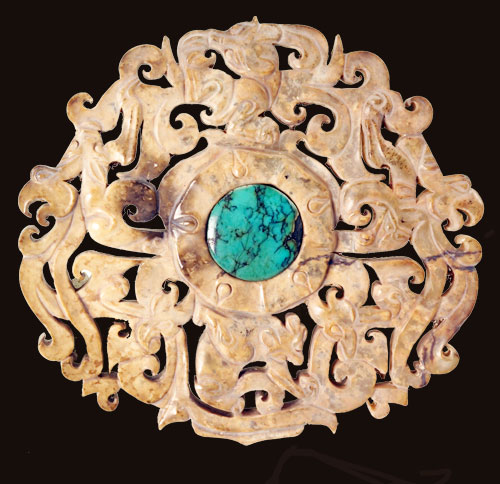
Jade Ornament with Animal Patterns
Western Han Dynasty (206BC—25AD)
Unearthed from Xiangbizui, Rongwan Town, Changsha, Hunan Province in 1978.
Diameter: 5.5-5.9cm; Thickness: 0.4cm
The surface of this jade ornament is grayish white due to corrosion. There is a piece of round-shaped turquoise inlaid in the center, around which are designs of dragon, phoenix and bear carved in openwork. A short column is arranged on the back, through which a small round hole runs for binding and fastening.
This jade ornament was originally decorated on a burial lacquerware which has already rotten away with age, and leaving behind only this piece of precious jade; thus one can imagine how gorgeous the lacquerware would be. This jade ornament, extremely exquisite in carving and imaginative in design and presentation, is crowned as the most outstanding artwork of its kind and represents the highest level of jade carving of Han Dynasty.
Chinese jade refers to any of the carved-jade objects produced in China from the Neolithic Period onward. The Chinese regarded carved-jade objects as intrinsically valuable. The Chinese loved jade not only because of its beauty, but more importantly, its embodied culture, meaning and humanity. Ancient Chinese believed that jade could bring them the blessings of the holy land, improve their health and protect you them from bad things. The wise have likened jade to virtue. For them, its polish and brilliancy represent the whole of purity; its perfect compactness and extreme hardness represent the sureness of intelligence; its angles, which do not cut, although they seem sharp, represent justice; the pure and prolonged sound, which it gives forth when one strikes it, represents music. Its color represents loyalty; its interior flaws, always showing themselves through the transparency, call to mind sincerity; its iridescent brightness represents heaven; its admirable substance, born of mountain and of water, represents the earth. Used alone without ornamentation it represents chastity. The price that the entire world attaches to it represents the truth. Thus jade is really unique in Chinese culture, also as the Chinese saying goes " Gold is valuable but jade is invaluable.
We Recommend:
